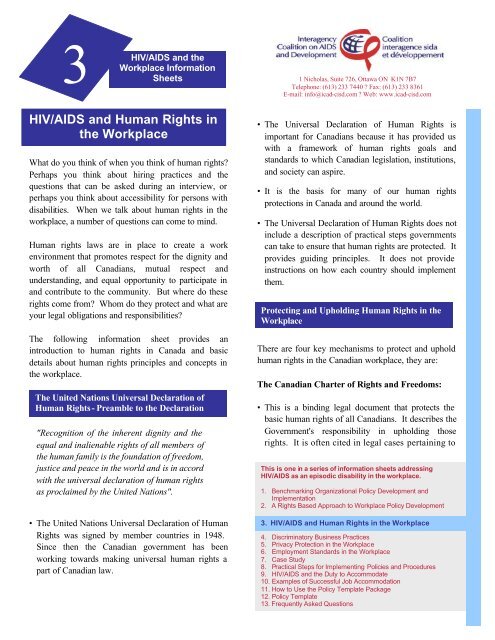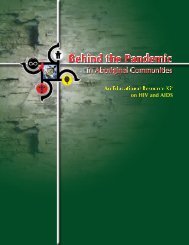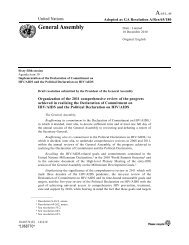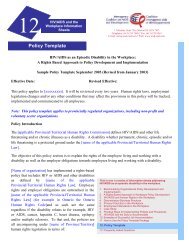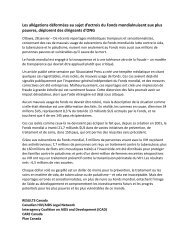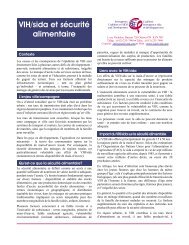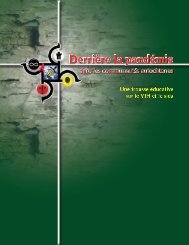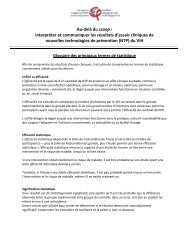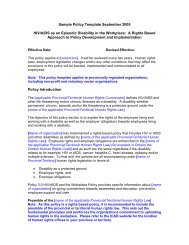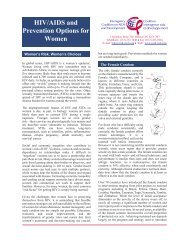HIV/AIDS and Human Rights in the Workplace
HIV/AIDS and Human Rights in the Workplace
HIV/AIDS and Human Rights in the Workplace
You also want an ePaper? Increase the reach of your titles
YUMPU automatically turns print PDFs into web optimized ePapers that Google loves.
3Information Series1 <strong>HIV</strong>/<strong>AIDS</strong> <strong>and</strong> <strong>the</strong><strong>Workplace</strong> InformationSheets<strong>HIV</strong>/<strong>AIDS</strong> <strong>and</strong> <strong>Human</strong> <strong>Rights</strong> <strong>in</strong><strong>the</strong> <strong>Workplace</strong>What do you th<strong>in</strong>k of when you th<strong>in</strong>k of human rights?Perhaps you th<strong>in</strong>k about hir<strong>in</strong>g practices <strong>and</strong> <strong>the</strong>questions that can be asked dur<strong>in</strong>g an <strong>in</strong>terview, orperhaps you th<strong>in</strong>k about accessibility for persons withdisabilities. When we talk about human rights <strong>in</strong> <strong>the</strong>workplace, a number of questions can come to m<strong>in</strong>d.<strong>Human</strong> rights laws are <strong>in</strong> place to create a workenvironment that promotes respect for <strong>the</strong> dignity <strong>and</strong>worth of all Canadians, mutual respect <strong>and</strong>underst<strong>and</strong><strong>in</strong>g, <strong>and</strong> equal opportunity to participate <strong>in</strong><strong>and</strong> contribute to <strong>the</strong> community. But where do <strong>the</strong>serights come from? Whom do <strong>the</strong>y protect <strong>and</strong> what areyour legal obligations <strong>and</strong> responsibilities?The follow<strong>in</strong>g <strong>in</strong>formation sheet provides an<strong>in</strong>troduction to human rights <strong>in</strong> Canada <strong>and</strong> basicdetails about human rights pr<strong>in</strong>ciples <strong>and</strong> concepts <strong>in</strong><strong>the</strong> workplace.The United Nations Universal Declaration of<strong>Human</strong> <strong>Rights</strong>- Preamble to <strong>the</strong> Declaration"Recognition of <strong>the</strong> <strong>in</strong>herent dignity <strong>and</strong> <strong>the</strong>equal <strong>and</strong> <strong>in</strong>alienable rights of all members of<strong>the</strong> human family is <strong>the</strong> foundation of freedom,justice <strong>and</strong> peace <strong>in</strong> <strong>the</strong> world <strong>and</strong> is <strong>in</strong> accordwith <strong>the</strong> universal declaration of human rightsas proclaimed by <strong>the</strong> United Nations".• The United Nations Universal Declaration of <strong>Human</strong><strong>Rights</strong> was signed by member countries <strong>in</strong> 1948.S<strong>in</strong>ce <strong>the</strong>n <strong>the</strong> Canadian government has beenwork<strong>in</strong>g towards mak<strong>in</strong>g universal human rights apart of Canadian law.1 Nicholas, Suite 726, Ottawa ON K1N 7B7Telephone: (613) 233 7440 ? Fax: (613) 233 8361E-mail: <strong>in</strong>fo@icad-cisd.com ? Web: www.icad-cisd.com• The Universal Declaration of <strong>Human</strong> <strong>Rights</strong> isimportant for Canadians because it has provided uswith a framework of human rights goals <strong>and</strong>st<strong>and</strong>ards to which Canadian legislation, <strong>in</strong>stitutions,<strong>and</strong> society can aspire.• It is <strong>the</strong> basis for many of our human rightsprotections <strong>in</strong> Canada <strong>and</strong> around <strong>the</strong> world.• The Universal Declaration of <strong>Human</strong> <strong>Rights</strong> does not<strong>in</strong>clude a description of practical steps governmentscan take to ensure that human rights are protected. Itprovides guid<strong>in</strong>g pr<strong>in</strong>ciples. It does not provide<strong>in</strong>structions on how each country should implement<strong>the</strong>m.Protect<strong>in</strong>g <strong>and</strong> Uphold<strong>in</strong>g <strong>Human</strong> <strong>Rights</strong> <strong>in</strong> <strong>the</strong><strong>Workplace</strong>There are four key mechanisms to protect <strong>and</strong> upholdhuman rights <strong>in</strong> <strong>the</strong> Canadian workplace, <strong>the</strong>y are:The Canadian Charter of <strong>Rights</strong> <strong>and</strong> Freedoms:• This is a b<strong>in</strong>d<strong>in</strong>g legal document that protects <strong>the</strong>basic human rights of all Canadians. It describes <strong>the</strong>Government's responsibility <strong>in</strong> uphold<strong>in</strong>g thoserights. It is often cited <strong>in</strong> legal cases perta<strong>in</strong><strong>in</strong>g toThis is one <strong>in</strong> a series of <strong>in</strong>formation sheets address<strong>in</strong>g<strong>HIV</strong>/<strong>AIDS</strong> as an episodic disability <strong>in</strong> <strong>the</strong> workplace.1. Benchmark<strong>in</strong>g Organizational Policy Development <strong>and</strong>Implementation2. A <strong>Rights</strong> Based Approach to <strong>Workplace</strong> Policy Development3. <strong>HIV</strong>/<strong>AIDS</strong> <strong>and</strong> <strong>Human</strong> <strong>Rights</strong> <strong>in</strong> <strong>the</strong> <strong>Workplace</strong>4. Discrim<strong>in</strong>atory Bus<strong>in</strong>ess Practices5. Privacy Protection <strong>in</strong> <strong>the</strong> <strong>Workplace</strong>6. Employment St<strong>and</strong>ards <strong>in</strong> <strong>the</strong> <strong>Workplace</strong>7. Case Study8. Practical Steps for Implement<strong>in</strong>g Policies <strong>and</strong> Procedures9. <strong>HIV</strong>/<strong>AIDS</strong> <strong>and</strong> <strong>the</strong> Duty to Accommodate10. Examples of Successful Job Accommodation11. How to Use <strong>the</strong> Policy Template Package12. Policy Template13. Frequently Asked Questions
human rights issues <strong>and</strong> guarantees that our laws <strong>and</strong><strong>the</strong> justice system operate <strong>in</strong> accordance withfundamental rights <strong>and</strong> freedoms.The Canadian <strong>Human</strong> <strong>Rights</strong> Act <strong>and</strong> TheCanadian <strong>Human</strong> <strong>Rights</strong> Commission:• Applies to workplaces that are <strong>in</strong>tegral to a federalundertak<strong>in</strong>g or <strong>the</strong> operation of which falls with<strong>in</strong>federal legislative authority.• Covers workplaces such as federal departments <strong>and</strong>agencies, crown corporations, <strong>the</strong> post office,airl<strong>in</strong>es, buses <strong>and</strong> railways which travel betweenprov<strong>in</strong>ces, chartered banks, telephone companies,radio or television stations, places of bus<strong>in</strong>ess wherelabour issues are governed by <strong>the</strong> Canada LabourCode <strong>and</strong> o<strong>the</strong>r federally-regulated <strong>in</strong>dustries.Prov<strong>in</strong>cial <strong>Human</strong> <strong>Rights</strong> Laws <strong>and</strong> Legislation:• Each prov<strong>in</strong>ce has its own human rights law, usuallycalled a Code or a Charter, that covers o<strong>the</strong>r types oforganizations not <strong>in</strong>cluded under federal legislation.Most not-for-profits are covered under prov<strong>in</strong>cial orterritorial human rights legislation.<strong>Human</strong> <strong>Rights</strong> Commissions, Tribunals <strong>and</strong> Offices:• Oversee <strong>the</strong> application of prov<strong>in</strong>cial human rightslaw <strong>and</strong> are also responsible for <strong>in</strong>vestigat<strong>in</strong>gcompla<strong>in</strong>ts, provid<strong>in</strong>g legal channels to hear <strong>the</strong>compla<strong>in</strong>ts, f<strong>in</strong>d<strong>in</strong>g solutions <strong>and</strong> work<strong>in</strong>g to educateus about human rights <strong>and</strong> promot<strong>in</strong>g equality forgroups <strong>in</strong> society that are frequently <strong>the</strong> target ofdiscrim<strong>in</strong>ation.In addition, each prov<strong>in</strong>ce has Employment St<strong>and</strong>ardsthat set out <strong>in</strong> law, certa<strong>in</strong> m<strong>in</strong>imum rights to whichemployees are entitled <strong>in</strong> <strong>the</strong> workplace cover<strong>in</strong>g manyaspects of employment <strong>in</strong>clud<strong>in</strong>g, but not limited to:m<strong>in</strong>imum wage, overtime, term<strong>in</strong>ation <strong>and</strong> severancepay, hours of work, public holidays <strong>and</strong> leave fromwork.Note: The Employment St<strong>and</strong>ards Act <strong>and</strong> <strong>Human</strong><strong>Rights</strong> legislation may apply at <strong>the</strong> same time. Thesetwo laws are not mutually exclusive.In Canada <strong>the</strong>re are also federal <strong>and</strong> prov<strong>in</strong>cial labourlaws that cover unionized workplaces, ensur<strong>in</strong>g <strong>the</strong>right to organize, encourage collective barga<strong>in</strong><strong>in</strong>g,promote harmonious labour relations <strong>and</strong> provide foreffective <strong>and</strong> fair dispute resolution.<strong>Human</strong> <strong>Rights</strong> Pr<strong>in</strong>ciples <strong>and</strong> Concepts <strong>in</strong> <strong>the</strong><strong>Workplace</strong>Every person has a right to equal treatment with respectto employment without discrim<strong>in</strong>ation <strong>and</strong> everyperson who is an employee has a right to freedom fromharassment <strong>in</strong> <strong>the</strong> workplace by <strong>the</strong> employer or agentof <strong>the</strong> employer or by ano<strong>the</strong>r employee because of <strong>the</strong>follow<strong>in</strong>g protected grounds (from <strong>the</strong> Ontario <strong>Human</strong><strong>Rights</strong> Code): race, ancestry, place of orig<strong>in</strong>, colour,ethnic orig<strong>in</strong>, citizenship, creed, sex (<strong>in</strong>cludespregnancy), sexual orientation, age, record of offences,marital status, same-sex partnership status, familystatus, disability <strong>and</strong>/or perceived disabilityNote: Protected grounds can vary between prov<strong>in</strong>cesor territories. Please consult <strong>the</strong> <strong>Human</strong> <strong>Rights</strong> Office<strong>in</strong> your location.The right to "equal treatment with respect toemployment" covers every aspect of <strong>the</strong> workplaceenvironment <strong>and</strong> employment relationship <strong>in</strong>clud<strong>in</strong>gjob applications, recruitment, tra<strong>in</strong><strong>in</strong>g, transfers,promotion, terms of apprenticeship, dismissal <strong>and</strong>layoffs. It also covers rate of pay, overtime, hours ofwork, holidays, benefits, shift-work, discipl<strong>in</strong>e,performance evaluations <strong>and</strong> any o<strong>the</strong>r terms <strong>and</strong>conditions that may apply.Who is Protected By <strong>Human</strong> <strong>Rights</strong> Legislation atWork?The protection extends to employees, temporary, casual<strong>and</strong> contract staff, <strong>in</strong>clud<strong>in</strong>g sub-contractors, as well aso<strong>the</strong>r persons <strong>in</strong> a work context <strong>in</strong>clud<strong>in</strong>g but notlimited to employees from employment agencies <strong>and</strong>persons hired as medical or personal attendants. The2
Ontario Code does not refer specifically to volunteersbut <strong>the</strong> Commission takes <strong>the</strong> position that <strong>the</strong> phrase"equal treatment with respect to employment" <strong>in</strong>section 5 can be <strong>in</strong>terpreted to protect anyone <strong>in</strong> awork-like context <strong>in</strong>clud<strong>in</strong>g <strong>in</strong>dividuals who workwithout a salary to ga<strong>in</strong> experience, such as those on apracticum or be<strong>in</strong>g mentored <strong>and</strong> persons provid<strong>in</strong>gvolunteer services. While <strong>the</strong>re have been no Ontariodecisions on <strong>the</strong>se issues, some British Columbiadecisions found that <strong>the</strong> prov<strong>in</strong>ce's human rights la wapplied to discrim<strong>in</strong>ation aga<strong>in</strong>st a volunteer, under <strong>the</strong>areas of employment <strong>and</strong> services.If you are <strong>in</strong> doubt about <strong>the</strong> <strong>in</strong>terpretation of "persons<strong>in</strong> a work context", or for fur<strong>the</strong>r <strong>in</strong>formation pleasecontact your local human rights office.Who is Responsible for Uphold<strong>in</strong>g <strong>Human</strong> <strong>Rights</strong> <strong>in</strong><strong>the</strong> <strong>Workplace</strong>?Compla<strong>in</strong>ts can be filed aga<strong>in</strong>st employers, contractors,unions, <strong>and</strong> directors or <strong>in</strong>dividuals such as o<strong>the</strong>remployees <strong>and</strong> supervisors. An employer's liability forharassment <strong>and</strong>/or discrim<strong>in</strong>ation committed by itsemployees <strong>and</strong> agents is not necessarily limited to <strong>the</strong>workplace or work hours.<strong>Human</strong> rights law <strong>in</strong>cludes <strong>the</strong> notion of <strong>the</strong> "extendedworkplace". Liability could attach to behavior oractions that occur away from <strong>the</strong> physical workplacebut that have implications or repercussions <strong>in</strong> <strong>the</strong>workplace. For example, staff may be held liable fordiscrim<strong>in</strong>atory <strong>in</strong>cidents tak<strong>in</strong>g place dur<strong>in</strong>g bus<strong>in</strong>essmeet<strong>in</strong>gs or trips, company parties, or o<strong>the</strong>r companyrelatedfunctions.Disability is a Protected Ground<strong>HIV</strong>/<strong>AIDS</strong> as well as o<strong>the</strong>r episodic disabilities is aprotected ground. The Ontario <strong>Human</strong> <strong>Rights</strong> Code,section 10, def<strong>in</strong>es disability to <strong>in</strong>clude:a) Any degree of physical disability, <strong>in</strong>firmity,malformation or disfigurement that is caused bybodily <strong>in</strong>jury, birth defect or illnessb) A condition of mental impairment ordevelopmental disabilityc) Learn<strong>in</strong>g disability, or a dysfunction <strong>in</strong> one or moreof <strong>the</strong> processes <strong>in</strong>volved <strong>in</strong> underst<strong>and</strong><strong>in</strong>g or us<strong>in</strong>gsymbols or spoken languaged) A mental disorder, ore) An <strong>in</strong>jury or disability for which benefits wereclaimed or received under <strong>the</strong> <strong>Workplace</strong> Safety<strong>and</strong> Insurance ActComparable prov<strong>in</strong>cial <strong>and</strong> territorial human rightslaws are <strong>in</strong> place across Canada. All def<strong>in</strong>e disabilityas a protected ground.<strong>Human</strong> <strong>Rights</strong> <strong>and</strong> DisabilityAccommodation is a means of remov<strong>in</strong>g barriersprevent<strong>in</strong>g persons with disabilities from fullparticipation <strong>in</strong> <strong>the</strong> workplace <strong>in</strong> a way that isresponsive to <strong>the</strong>ir <strong>in</strong>dividual circumstances.People with a disability have <strong>the</strong> right to have <strong>the</strong>ir<strong>in</strong>dividual needs accommodated, up to <strong>the</strong> po<strong>in</strong>t ofundue hardship, <strong>in</strong> order to allow <strong>the</strong>m to perform <strong>the</strong>essential duties of <strong>the</strong>ir job.3


